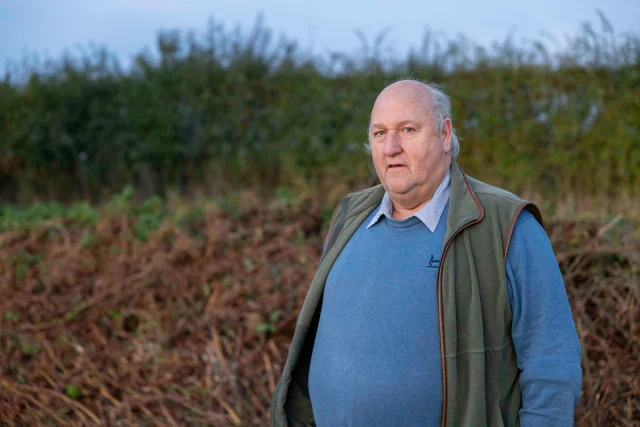Published on 1st February 2023
Disease Management
Disease control programme put to the test with farm trial

An integrated disease management programme will help avoid unnecessary contingency spend. That’s the view of Andrew and Sam Melton of H Melton & Son on the Norfolk, Cambridge border.
The 660 ha farm is close enough to The Wash to get hit with yellow rust and Septoria, the latter being the key concern most seasons. Despite those twin threats and climate volatility, their disease control strategy is working well.
But as with most things Andrew and Sam wanted to be sure, so they put their standard approach to the test. They investigated whether it was possible to reduce T0 and/or T1 treatments – understandable given recent spring droughts.
The plots were monitored using FieldView and it was only when Andrew and Sam evaluated the data the differences became apparent. “The spring of 2021 was dry and visually we couldn’t really see a great deal of difference between the trial plots and our standard programme, even ahead of T2 applications. But then disease then came in rapidly – when we looked at the yield data the differences became apparent. It proved to us what we are doing on farm is the right approach,” notes Sam.
That right approach starts with variety selection. Andrew and Sam grow a mixture of wheats across their area but Crusoe, Astronomer and Dawsum all have good Septoria and yellow rust ratings, all are above a six for Septoria and for yellow rust they are even better. “With all our wheats we’re looking for quality, even with Dawsum which has good specific weight. But we want disease resistance too,” notes Andrew.
Equally important is the need to get application timings right, so Andrew and Sam take the time to check fields for leaf emergence.
Alongside foliar threats, other diseases can threaten from time to time. What Andrew and Sam are looking for with their disease control programme is broad-spectrum protection.
The current disease control strategy is a four-spray programme using primary and secondary azoles. Last season’s programme was a T0 of tebuconazole, Ascra (prothioconazole + bixafen + fluopyram) at the T1, and in some cases again at the T2. For those varieties with lower Septoria rating the choice being Univoq® (prothioconazole + fenpicoxamid) or Revystar® (mefentrifluconazole + fluxapyroxad. The programme closed with a ‘dual purpose’ T3. This being a guard against Fusarium with premium wheat Crusoe, and a foliar top-up for feed wheats. With yellow rust concerns, tebuconazole can be included at the T1 and/or T2, if the disease threatens.
The loss of tebuconazole is a concern given the yellow rust risk. Andrew and Sam haven’t made any firm decisions yet on how they will counter its withdrawal but one consideration is to go ‘less, more often.’ “Reduced rates at closer intervals might be the way to go,” adds Andrew. “Either way we’ll put it to the test.”
Assisting could be some sophisticated technology from Bayer. Andrew and Sam are trialling a new predictive disease tool. It uses climatory indicators combined with data-driven algorithms to refine fungicide decisions.
They hope it will help make fungicides timings even more accurate. “It provides us with regular in-season risk assessments. The expectation is that we might be able to be even more precise with our application timings,” says Andrew
Nothing beats on-farm trials
As an AHDB monitor farm, Andrew and Sam undertake extensive farm trials.
As well as fungicides, over the last three seasons this has included cultivation work, cover crops and NUE strategies. All of course are important, but a key area is an in-depth look at cultivation strategies. Under investigation is fuel savings, capital expenditure and benefits with soil structure.
There has always been a certain element of ploughing on the farm. They doubt that they can go completely to a no-till system but reduced tillage is already delivering benefits in soil structure. This has allowed easier field travel but also helped with moisture retention.
It has also demonstrated the wide differential in operational costs across various cultivation strategies – after depreciation is factored in Sam calculated tillage costs of 30/ha to £116.00/ha.
The trials were based around their traditional plough with a double press versus various shallow and no-till cultivation approached with a Vaderstad Carrier with cross cutter discs, plus in some cases a Tilso Sabre Tine to work soils a little deeper. But these also included plots covering straw removal, cover and catch crops.
The aim of the catch crop trial was to take a pass out and put roots down plots. It kept the soil surface moist but over two seasons establishing winter cereals was a challenge, the window being just too narrow.
The cover crop trials were more successful and now this is employed ahead of spring crops. “This is part of a reduced tillage system. It helps protect the soil from heavy rainfall in the autumn, aids drainage in the following crop and we suspect it helps hold to some nutrition too, rather than it being washed through the soil profile,” adds Andrew.
But they note that ploughing is still a useful option and dispensing with it is probably unwise. Although there is a lot less inversion tillage being employed, seasons of data captured by FieldView shows that in wetter periods it can be the better option.
Acknowledgements: Ascra is a trademark of Bayer. Ascra Xpro contains bixafen, fluopyram and prothioconazole. Revystar is a trademark of BASF. Revystar XE contains fluxapyroxad and mefentrifluconazole. Univoq is a trademark of Corteva Agriscience. Univoq contains fenpicoxamid and prothioconazole.



